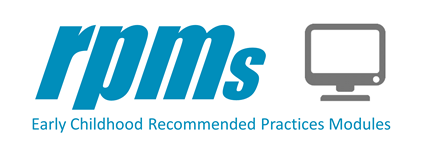Resource Search
Keyword Search
15 results found
Let's watch a parent-child interaction with a mother who is responding positively to her child. Notice how this mother repeats what her child says and uses words to name ingredients and extend what her child says. She uses words to explain what her child is doing when she has measuring cups. She also explains the usefulness of the measuring cups. You can think of this as answering a question a child could have asked, but didn’t. She promptly replies, showing that she is paying attention to her child’s comments, but also waits after responding to let her child process what has been said.
Let's watch a video of a father and an older child both attending to a book about trains. Notice how this father is providing an opportunity to interact with his son. This activity is giving his son the opportunity to express himself both verbally and nonverbally, showing his interest. This father is paying attention to the child’s interest and expanding on what his child says with new words and information.
In this activity the child is interacting with an adult. He is able to express his emotions through smiling and acting shy. He is able to communicate both verbally and nonverbally. This activity builds social and emotional competence because this father is paying attention and responding to his son, giving him the message that he matters!
In this video you will see a child sitting on his mother’s lap playing with a toy. Pay attention to the behaviors he uses to interact with his mother during this activity.
In this video clip you will see a child playing in a creek. Note the child’s behaviors that can be observed during this interaction. Make some notes about what you see the child doing to interact and what abilities you observe.
In this video clip you will see a child engaging in water play. Pay attention to the behaviors to show what holds his interest.
In this video clip you will see a child playing in a pool of balls. Take notes about the child’s behaviors that show his interests.
In this video clip you will see a typical classroom activity. Notice how this teacher is paying attention to what the children are doing and their attempts to interact with the blocks. Make notes about how the teacher notices what the children want to do with the blocks.
In this video and see if you can identify the material adaptation that has been made so that the child can eat his lunch independently.
Here is a video example of a teacher using individualized instruction to support a child in the activity of transitioning. Watch how the teacher uses an individual picture schedule to support the child in the activity of transitioning from outdoor play to lining up with her peers. The teacher has created a personal schedule for the child using photos of her participating in the daily activities. This adaptation provides both visual and auditory support in helping the child prepare for and participate in transitioning from outside play time to lining up, to meal time indoors.
In this video clip, we observe a child who is blind. His teacher has observed that the child’s level of participation during shared story book reading is low. In response to the low participation, his teacher has decided to create a book that allows the child to touch and move parts of the book.
In this video, try to identify the following: How is the child involved in the activity? How might she be more involved? Can you identify an adaptation that might support her involvement?
In this example, you will see that the mother has provided an adaptation by moving a chair next to the sink so the child is able to reach the sink.
In this video notice how the teacher provides the child enough time to complete the target behavior of the student writing his name. She also uses explicit feedback - she said “See how well you did it... every letter.” It is clear to the child what the target skill was and that he did it correctly.
Watch this video of a family eating pizza. The mom is working on counting and embedding this target skill into an everyday activity, eating a meal.
